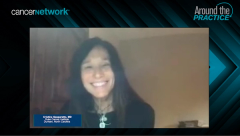
Transplant-Ineligible MM: Treatment After Adequate Response to Therapy
A panel of experts reflects on appropriate actions to take after a patient achieves adequate response to therapy for transplant-ineligible multiple myeloma.
Episodes in this series

Transcript:
C. Ola Landgren, MD, PhD:Let’s go to the next polling question. This is No. 4, and this will be the last question. We’ll then have a little discussion, and I’ll move to the second segment. If a patient achieves what you consider to be an adequate treatment response, what is likely to be your next step? Continue therapy as is, change and try to achieve a better response, or discontinue the therapy? Continue therapy seems to be the most common choice. If a patient has an adequate response, many times in my practice I’d consider stepping down intensity almost like a maintenance approach. Of course, it depends on what the initial therapy is. That wasn’t an option. The only options are to continue or to change to something to have a better response. But the question was what if the patient has an adequate response? The third option is to stop therapy. That was obviously not an option. What would you do in this scenario, Peter?
Peter Voorhees, MD: I always tell patients: when in Rome, do what the Romans do. If you’re using a particular regimen and you want to achieve the results from that regimen that we’re seeing in the clinical trials or approach something close to that, then you’ve got to apply it in the same manner that it was studied. In the absence of unacceptable toxicities, we’ve got good data that you can strip out the dexamethasone after 9 cycles of therapy, so it depends on the regimen. Like in the SWOG S0777 trial, patients got 24 weeks of 3-drug therapy and then went on to lenalidomide-dexamethasone until disease progression. I wouldn’t use the dexamethasone until disease progression there, but they did de-escalate therapy in that trial. In the MAIA trial of daratumumab-lenalidomide-dexamethasone, they continued all 3 agents until disease progression, unless they had unacceptable adverse effects. Thus, I usually try to stick to the script when I can.
C. Ola Landgren, MD, PhD:Craig, what do you do in your practice?
Craig Hofmeister, MD, MPH: I can’t say that better than Peter, so I have nothing else to add. Well said.
C. Ola Landgren, MD, PhD:Cristina, what do you think?
Cristina Gasparetto, MD: I agree. In the older, more frail population of patients, we need to de-escalate at a certain point for sustainability. There was a paper presented a few years ago—from an Italian group, so I remember that for that reason—in very frail older patients, comparing continuation of therapy vs Revlimid. It was very important to show that there was no difference with or without the dexamethasone for the continuation of therapy. I always remember that trial. After awhile, you have to de-escalate some of the therapy. The MAIA trial is a de-escalation by protocol because the data go monthly, so you may choose to continue the dexamethasone the day of the data only and continue the Revlimid. I do that.
C. Ola Landgren, MD, PhD:Because I’m trying to bring out a different perspective, I’ll try to take a different side. I agree with everything you bring up. Peter, you say you follow the protocol. But if you drill into the paper on the MAIA study, you mentioned that it’s continuously daratumumab-lenalidomide-dexamethasone. But look at the updated presentation that Thierry Facon did at EHA [European Hematology Association Congress], the relative dose intensity. Cristina and I talked about this the other week. If you look at how many patients stopped Revlimid or daratumumab-lenalidomide-dexamethasone, it’s very high. I don’t have the exact number, but it’s close to 50%, at least during some phases of the study. My point is that the studies are written in 1 way, but what happened in the trials is not exactly what’s written. I just wanted to throw that out there. What do you think about that?
Peter Voorhees, MD: That’s an incredibly good point. When you’re using triplets or quadruplets, and you’re having an amazing response to those therapies, we feel emboldened to be able to make adjustments more readily when patients’ quality of life is suffering. If you’ve got somebody on daratumumab-lenalidomide-dexamethasone and they have terrible fatigue and diarrhea from the lenalidomide, you’re going to feel more comfortable stripping that away if they’re still on the daratumumab. That tells you that you can make modifications to therapy based on adverse effects and do it successfully in these platforms.
C. Ola Landgren, MD, PhD:What we’re saying between the lines is that, although there’s no doubt that the 3-drug-arm was the winner over the 2-drug arm, because all the patients didn’t get Revlimid because of adverse effects, they’re reducing the dose. Following efficacy would have been even more profound if all the patients have gotten all the doses of everything. But that’s not how it works in the real world. Every patient cannot tolerate every drug in every cycle.
Transcript edited for clarity.
Newsletter
Stay up to date on recent advances in the multidisciplinary approach to cancer.























































































